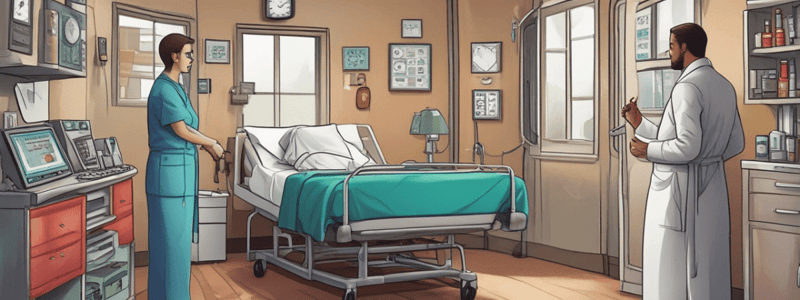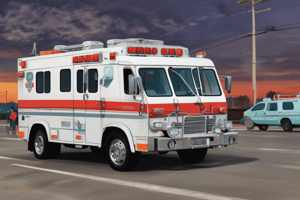Podcast
Questions and Answers
Who assigns Level 1 reviews?
Who assigns Level 1 reviews?
- EMT or Paramedic
- Fire Chief
- Medical Battalion Chief (correct)
- Medical Director
Within how many days must a Level 1 review be completed?
Within how many days must a Level 1 review be completed?
- 7 days
- 14 days (correct)
- 21 days
- 10 days
What is the focus of a Level 1 review?
What is the focus of a Level 1 review?
- Medical Director's orders
- EMT or Paramedic certification
- Patient care and treatment
- Compliance with STJFD Standard Operating Guideline 200.07 (correct)
When does a review elevate to Level 2?
When does a review elevate to Level 2?
Who conducts a Level 2 review?
Who conducts a Level 2 review?
What happens when a review is not resolved at Level 2?
What happens when a review is not resolved at Level 2?
Who conducts a Level 3 review?
Who conducts a Level 3 review?
What is the purpose of a Level 3 review?
What is the purpose of a Level 3 review?
Who communicates the results and required action to the member being reviewed?
Who communicates the results and required action to the member being reviewed?
What is forwarded with the request for a Level 3 review?
What is forwarded with the request for a Level 3 review?
Flashcards are hidden until you start studying
Study Notes
Patient Care Reporting
- St. John's Fire District (STJFD) uses electronic patient care reporting (ePCR) software to formally document all patient encounters and treatment.
- The approved ePCR software is ImageTrend "Field".
- All required fields in the reporting software must be accurately completed within 24 hours of incident notification.
- Vital signs must be documented for each patient encounter.
ePCR Narrative
- The narrative should further explain and document treatment information on a patient.
- The narrative format includes:
- Dispatched To: initial call description and units dispatched
- Upon Arrival: incident scene description
- Chief Complaint: patient's expressed chief complaint and secondary complaints (if applicable)
- Primary Assessment: first impression, patient's level of consciousness, airway, breathing, circulation, history of present illnesses, past medical history, and life-threatening conditions
- Secondary/Focused Assessment: detailed physical exam, pertinence negatives, lung sounds, and blood glucose level
- Treatments: all treatments provided to the patient
- Ongoing Assessment: patient's response to treatments, medications, or additional assessments
- Notes: description of patient turnover to the transporting EMS agency, including ALS/BLS transport unit number or identification, and transfer of patient care
Additional Requirements
- Airway placement must be confirmed by checking chest rise and lung sounds, and consideration for capnography should be documented if applicable.
- If a patient with injury refuses treatment, the EMT or Paramedic must document findings as for any other patient, adhering to criteria and Charleston County Clinical Operating Guidelines.
- A medical treatment refusal form must be completed for any patient who originally had a complaint of injury or illness.
Notifications
- Notification must be made to the STJFD Medical Battalion Chief anytime an automatic external defibrillator (AED) is used, to ensure data is downloaded for analysis and record-keeping.
Patient Refusals
- When a patient chooses to refuse care or transport, the STJFD patient refusal form must be completed and signed by the patient.
- The EMT must ensure the form is completed and signed, and the ePCR report writer must select the patient disposition of "refusal" within the ImageTrend NEMSIS 3.5 system.
- The signed refusal form must be uploaded into the ePCR in .pdf format.
Medical Quality Assurance and Improvement
- The purpose of the quality improvement program is to ensure that emergency medical care is rendered in a professional and systematic format.
- The Medical Battalion Chief, with coordinated efforts from command staff and Medical Director, will provide a thorough review of emergency medical incidents.
- Company officers are responsible for ensuring patient care reports are completed by personnel assigned to them.
- The Medical Battalion Chief will initiate a Level 1 review on all incidents that mandate review.
Level 1 Review
- Level 1 review will be performed on reports that warrant review based on identified priorities.
- Level 1 reviews will be assigned by the Medical Battalion Chief and completed by designated EMTs or Paramedics within 14 days of the assignment date.
- The focus of this review will be the care provider's compliance with STJFD Standard Operating Guideline 200.07, along with appropriate protocol selection and adherence to the selected protocol.
Level 2 and 3 Reviews
- Level 2 reviews will be conducted when the EMT or Paramedic conducting a Level 1 review identifies infractions or deviations from protocol.
- Level 3 reviews will be conducted when further action is warranted based on the findings of the Level 2 review.
- Level 3 reviews will be conducted by members of Command Staff under the consultation of the Medical Director as deemed necessary.
Studying That Suits You
Use AI to generate personalized quizzes and flashcards to suit your learning preferences.




